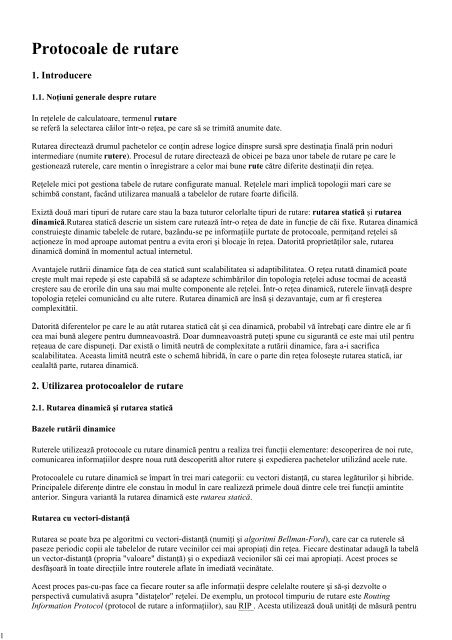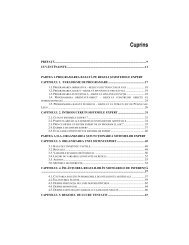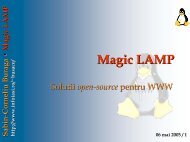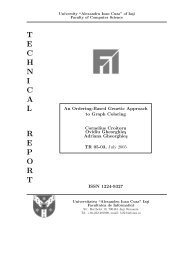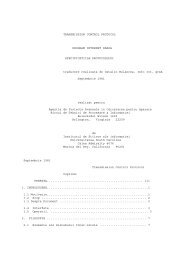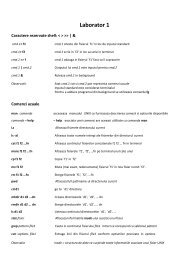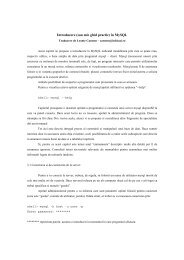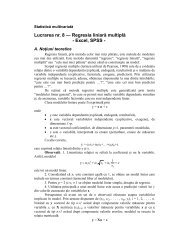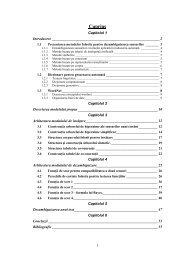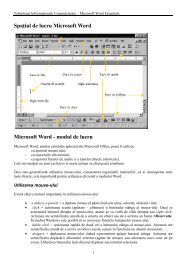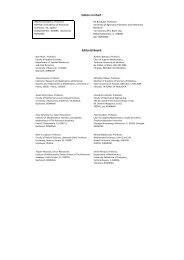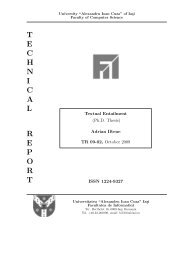Protocoale de rutare - Profs.info.uaic.ro
Protocoale de rutare - Profs.info.uaic.ro
Protocoale de rutare - Profs.info.uaic.ro
Create successful ePaper yourself
Turn your PDF publications into a flip-book with our unique Google optimized e-Paper software.
1<br />
<st<strong>ro</strong>ng>P<strong>ro</strong>tocoale</st<strong>ro</strong>ng> <st<strong>ro</strong>ng>de</st<strong>ro</strong>ng> <st<strong>ro</strong>ng>rutare</st<strong>ro</strong>ng><br />
1. Int<strong>ro</strong>ducere<br />
1.1. Noţiuni generale <st<strong>ro</strong>ng>de</st<strong>ro</strong>ng>spre <st<strong>ro</strong>ng>rutare</st<strong>ro</strong>ng><br />
In reţelele <st<strong>ro</strong>ng>de</st<strong>ro</strong>ng> calculatoare, termenul <st<strong>ro</strong>ng>rutare</st<strong>ro</strong>ng><br />
se referă la selectarea căilor într-o reţea, pe care să se trimită anumite date.<br />
Rutarea directează drumul pachetelor ce conţin adrese logice dinspre sursă spre <st<strong>ro</strong>ng>de</st<strong>ro</strong>ng>stinaţia finală prin noduri<br />
intermediare (numite rutere). P<strong>ro</strong>cesul <st<strong>ro</strong>ng>de</st<strong>ro</strong>ng> <st<strong>ro</strong>ng>rutare</st<strong>ro</strong>ng> directează <st<strong>ro</strong>ng>de</st<strong>ro</strong>ng> obicei pe baza unor tabele <st<strong>ro</strong>ng>de</st<strong>ro</strong>ng> <st<strong>ro</strong>ng>rutare</st<strong>ro</strong>ng> pe care le<br />
gestionează ruterele, care mentin o înregistrare a celor mai bune rute către diferite <st<strong>ro</strong>ng>de</st<strong>ro</strong>ng>stinaţii din reţea.<br />
Reţelele mici pot gestiona tabele <st<strong>ro</strong>ng>de</st<strong>ro</strong>ng> <st<strong>ro</strong>ng>rutare</st<strong>ro</strong>ng> configurate manual. Reţelele mari implică topologii mari care se<br />
schimbă constant, facând utilizarea manuală a tabelelor <st<strong>ro</strong>ng>de</st<strong>ro</strong>ng> <st<strong>ro</strong>ng>rutare</st<strong>ro</strong>ng> foarte dificilă.<br />
Exiztă două mari tipuri <st<strong>ro</strong>ng>de</st<strong>ro</strong>ng> <st<strong>ro</strong>ng>rutare</st<strong>ro</strong>ng> care stau la baza tutu<strong>ro</strong>r celorlalte tipuri <st<strong>ro</strong>ng>de</st<strong>ro</strong>ng> <st<strong>ro</strong>ng>rutare</st<strong>ro</strong>ng>: <st<strong>ro</strong>ng>rutare</st<strong>ro</strong>ng>a statică şi <st<strong>ro</strong>ng>rutare</st<strong>ro</strong>ng>a<br />
dinamică.Rutarea statică <st<strong>ro</strong>ng>de</st<strong>ro</strong>ng>scrie un sistem care rutează într-o reţea <st<strong>ro</strong>ng>de</st<strong>ro</strong>ng> date in funcţie <st<strong>ro</strong>ng>de</st<strong>ro</strong>ng> căi fixe. Rutarea dinamică<br />
construieşte dinamic tabelele <st<strong>ro</strong>ng>de</st<strong>ro</strong>ng> <st<strong>ro</strong>ng>rutare</st<strong>ro</strong>ng>, bazându-se pe <st<strong>ro</strong>ng>info</st<strong>ro</strong>ng>rmaţiile purtate <st<strong>ro</strong>ng>de</st<strong>ro</strong>ng> p<strong>ro</strong>tocoale, permiţand reţelei să<br />
acţioneze în mod ap<strong>ro</strong>ape automat pentru a evita e<strong>ro</strong>ri şi blocaje în reţea. Datorită p<strong>ro</strong>prietăţilor sale, <st<strong>ro</strong>ng>rutare</st<strong>ro</strong>ng>a<br />
dinamică domină în momentul actual internetul.<br />
Avantajele rutării dinamice faţa <st<strong>ro</strong>ng>de</st<strong>ro</strong>ng> cea statică sunt scalabilitatea si adaptibilitatea. O reţea rutată dinamică poate<br />
creşte mult mai repe<st<strong>ro</strong>ng>de</st<strong>ro</strong>ng> şi este capabilă să se adapteze schimbărilor din topologia reţelei aduse tocmai <st<strong>ro</strong>ng>de</st<strong>ro</strong>ng> această<br />
creştere sau <st<strong>ro</strong>ng>de</st<strong>ro</strong>ng> e<strong>ro</strong>rile din una sau mai multe componente ale reţelei. Într-o reţea dinamică, ruterele îinvaţă <st<strong>ro</strong>ng>de</st<strong>ro</strong>ng>spre<br />
topologia reţelei comunicând cu alte rutere. Rutarea dinamică are însă şi <st<strong>ro</strong>ng>de</st<strong>ro</strong>ng>zavantaje, cum ar fi creşterea<br />
complexitătii.<br />
Datorită diferentelor pe care le au atât <st<strong>ro</strong>ng>rutare</st<strong>ro</strong>ng>a statică cât şi cea dinamică, p<strong>ro</strong>babil vă întrebaţi care dintre ele ar fi<br />
cea mai bună alegere pentru dumneavoastră. Doar dumneavoastră puteţi spune cu sigurantă ce este mai util pentru<br />
reţeaua <st<strong>ro</strong>ng>de</st<strong>ro</strong>ng> care dispuneţi. Dar există o limită neutră <st<strong>ro</strong>ng>de</st<strong>ro</strong>ng> complexitate a rutării dinamice, fara a-i sacrifica<br />
scalabilitatea. Aceasta limită neutră este o schemă hibridă, în care o parte din reţea foloseşte <st<strong>ro</strong>ng>rutare</st<strong>ro</strong>ng>a statică, iar<br />
cealaltă parte, <st<strong>ro</strong>ng>rutare</st<strong>ro</strong>ng>a dinamică.<br />
2. Utilizarea p<strong>ro</strong>tocoalelor <st<strong>ro</strong>ng>de</st<strong>ro</strong>ng> <st<strong>ro</strong>ng>rutare</st<strong>ro</strong>ng><br />
2.1. Rutarea dinamică şi <st<strong>ro</strong>ng>rutare</st<strong>ro</strong>ng>a statică<br />
Bazele rutării dinamice<br />
Ruterele utilizează p<strong>ro</strong>tocoale cu <st<strong>ro</strong>ng>rutare</st<strong>ro</strong>ng> dinamică pentru a realiza trei funcţii elementare: <st<strong>ro</strong>ng>de</st<strong>ro</strong>ng>scoperirea <st<strong>ro</strong>ng>de</st<strong>ro</strong>ng> noi rute,<br />
comunicarea <st<strong>ro</strong>ng>info</st<strong>ro</strong>ng>rmaţiilor <st<strong>ro</strong>ng>de</st<strong>ro</strong>ng>spre noua rută <st<strong>ro</strong>ng>de</st<strong>ro</strong>ng>scoperită altor rutere şi expedierea pachetelor utilizând acele rute.<br />
<st<strong>ro</strong>ng>P<strong>ro</strong>tocoale</st<strong>ro</strong>ng>le cu <st<strong>ro</strong>ng>rutare</st<strong>ro</strong>ng> dinamică se împart în trei mari categorii: cu vectori distanţă, cu starea legăturilor şi hibri<st<strong>ro</strong>ng>de</st<strong>ro</strong>ng>.<br />
Principalele diferenţe dintre ele constau în modul în care realizeză primele două dintre cele trei funcţii amintite<br />
anterior. Singura variantă la <st<strong>ro</strong>ng>rutare</st<strong>ro</strong>ng>a dinamică este <st<strong>ro</strong>ng>rutare</st<strong>ro</strong>ng>a statică.<br />
Rutarea cu vectori-distanţă<br />
Rutarea se poate bza pe algoritmi cu vectori-distanţă (numiţi şi algoritmi Bellman-Ford), care car ca ruterele să<br />
paseze periodic copii ale tabelelor <st<strong>ro</strong>ng>de</st<strong>ro</strong>ng> <st<strong>ro</strong>ng>rutare</st<strong>ro</strong>ng> vecinilor cei mai ap<strong>ro</strong>piaţi din reţea. Fiecare <st<strong>ro</strong>ng>de</st<strong>ro</strong>ng>stinatar adaugă la tabelă<br />
un vector-distanţă (p<strong>ro</strong>pria "valoare" distanţă) şi o expediază vecionilor săi cei mai ap<strong>ro</strong>piaţi. Acest p<strong>ro</strong>ces se<br />
<st<strong>ro</strong>ng>de</st<strong>ro</strong>ng>sfăşoară în toate direcţiile între <strong>ro</strong>uterele aflate în imediată vecinătate.<br />
Acest p<strong>ro</strong>ces pas-cu-pas face ca fiecare <strong>ro</strong>uter sa afle <st<strong>ro</strong>ng>info</st<strong>ro</strong>ng>rmaţii <st<strong>ro</strong>ng>de</st<strong>ro</strong>ng>spre celelalte <strong>ro</strong>utere şi să-şi <st<strong>ro</strong>ng>de</st<strong>ro</strong>ng>zvolte o<br />
perspectivă cumulativă asupra "distaţelor" reţelei. De exemplu, un p<strong>ro</strong>tocol timpuriu <st<strong>ro</strong>ng>de</st<strong>ro</strong>ng> <st<strong>ro</strong>ng>rutare</st<strong>ro</strong>ng> este Routing<br />
Information P<strong>ro</strong>tocol (p<strong>ro</strong>tocol <st<strong>ro</strong>ng>de</st<strong>ro</strong>ng> <st<strong>ro</strong>ng>rutare</st<strong>ro</strong>ng> a <st<strong>ro</strong>ng>info</st<strong>ro</strong>ng>rmaţiilor), sau RIP . Acesta utilizează două unităţi <st<strong>ro</strong>ng>de</st<strong>ro</strong>ng> măsură pentru
2<br />
distanţe ca să <st<strong>ro</strong>ng>de</st<strong>ro</strong>ng>termine cea mai bună cale următoare pentru orice pachet. Aceste unităţi <st<strong>ro</strong>ng>de</st<strong>ro</strong>ng> măsură pentru distanţă,<br />
tacturile şi hopurile, sunt <st<strong>ro</strong>ng>de</st<strong>ro</strong>ng>pen<st<strong>ro</strong>ng>de</st<strong>ro</strong>ng>nte <st<strong>ro</strong>ng>de</st<strong>ro</strong>ng> timp.<br />
Tabela cumulativă este apoi utilizată pentru actualizarea tabelelor <st<strong>ro</strong>ng>de</st<strong>ro</strong>ng> <st<strong>ro</strong>ng>rutare</st<strong>ro</strong>ng> ale fiecărui <strong>ro</strong>uter. La finalul<br />
p<strong>ro</strong>cesului, fiecare <strong>ro</strong>uter a aflat niste <st<strong>ro</strong>ng>info</st<strong>ro</strong>ng>rmaţii vagi <st<strong>ro</strong>ng>de</st<strong>ro</strong>ng>spre distanţele până la resursele din reţea. El nu a aflat<br />
nimic specific <st<strong>ro</strong>ng>de</st<strong>ro</strong>ng>spre alte <strong>ro</strong>utere sau <st<strong>ro</strong>ng>de</st<strong>ro</strong>ng>spre topologia reală a reţelei.<br />
Această abordare poate, în anumite circumstanţe, să creeze p<strong>ro</strong>bleme <st<strong>ro</strong>ng>de</st<strong>ro</strong>ng> <st<strong>ro</strong>ng>rutare</st<strong>ro</strong>ng> pentru p<strong>ro</strong>tocoalele bazate pe<br />
vectori-distanţă. De exemplu, în urma unei că<st<strong>ro</strong>ng>de</st<strong>ro</strong>ng>ri în reţea eset necesar ceva timp pentru ca <strong>ro</strong>uterele să conveargă<br />
spre o nouă înţelegere a topologiei reţelei. În timpul acestui p<strong>ro</strong>ces, reţeaua ar putea fi vulnerabilă la rutări<br />
contradictorii şi chiar la bucle infinite.<br />
Anumite măsuri <st<strong>ro</strong>ng>de</st<strong>ro</strong>ng> siguranţă ar putea să micşoreze aceste riscuri, dar rămâne faptul că performanţa reţelei este<br />
expusă riscurilor în timpul p<strong>ro</strong>cesului <st<strong>ro</strong>ng>de</st<strong>ro</strong>ng> convergenţă. Prin urmare, este posibil ca p<strong>ro</strong>tocoalele mai vechi care<br />
converg lent să nu fie potrivite pentru WAN-urile extinse, complexe.<br />
Rutarea cu starea legăturilor<br />
Algoritmii <st<strong>ro</strong>ng>de</st<strong>ro</strong>ng> <st<strong>ro</strong>ng>rutare</st<strong>ro</strong>ng> folosind starea legăturilor (link-state <strong>ro</strong>uting algorithm), cunoscuţi collectiv ca p<strong>ro</strong>tocoale cu<br />
preferarea drumului minim (SPF), menţin o bază <st<strong>ro</strong>ng>de</st<strong>ro</strong>ng> date complexă a topologiei reţelei. Spre <st<strong>ro</strong>ng>de</st<strong>ro</strong>ng>osebire <st<strong>ro</strong>ng>de</st<strong>ro</strong>ng><br />
p<strong>ro</strong>tocoalele cu vectori-distanţă, cele folosind starea legăturilor <st<strong>ro</strong>ng>de</st<strong>ro</strong>ng>zvoltă şi întreţin o cunoaştere completă a<br />
<strong>ro</strong>uterelor <st<strong>ro</strong>ng>de</st<strong>ro</strong>ng> reţea, ca şi a felului cum sunt interconectate acestea.<br />
Această cunoştere este realizată prin schimbarea <st<strong>ro</strong>ng>de</st<strong>ro</strong>ng> pachete cu starea legăturilor (LSP) cu alte <strong>ro</strong>utere conectate<br />
direct. Fiecare <strong>ro</strong>uter care a schimbat LSP-uri construieşte apoi o bază <st<strong>ro</strong>ng>de</st<strong>ro</strong>ng> date logicş utilizănd toate LSP-urile<br />
primite. Este utilizat apoi un algoritm "cu preferarea drumului liber", pentru a calcula cât <st<strong>ro</strong>ng>de</st<strong>ro</strong>ng> accesibile sunt<br />
<st<strong>ro</strong>ng>de</st<strong>ro</strong>ng>stinaţiile legate <st<strong>ro</strong>ng>de</st<strong>ro</strong>ng> reţea. Această <st<strong>ro</strong>ng>info</st<strong>ro</strong>ng>rmaţie este utilizată pentru a actualiza tabela <st<strong>ro</strong>ng>de</st<strong>ro</strong>ng> <st<strong>ro</strong>ng>rutare</st<strong>ro</strong>ng>. Acvest p<strong>ro</strong>ces este<br />
capabil să <st<strong>ro</strong>ng>de</st<strong>ro</strong>ng>scopere modificările topologiei reţelei, care ar putea fi cauzate <st<strong>ro</strong>ng>de</st<strong>ro</strong>ng> că<st<strong>ro</strong>ng>de</st<strong>ro</strong>ng>rea unei componente sau <st<strong>ro</strong>ng>de</st<strong>ro</strong>ng><br />
mărirea reţelei. De fapt, schimbul <st<strong>ro</strong>ng>de</st<strong>ro</strong>ng> LSP-uri este <st<strong>ro</strong>ng>de</st<strong>ro</strong>ng>clanşat <st<strong>ro</strong>ng>de</st<strong>ro</strong>ng> un eveniment din reţea, nu este realizat periodic.<br />
Rutarea cu starea legăturilor are două zone parţiale <st<strong>ro</strong>ng>de</st<strong>ro</strong>ng> risc. Mai înâi, în timpul p<strong>ro</strong>cesului iniţial <st<strong>ro</strong>ng>de</st<strong>ro</strong>ng> <st<strong>ro</strong>ng>de</st<strong>ro</strong>ng>scoperire,<br />
<st<strong>ro</strong>ng>rutare</st<strong>ro</strong>ng>a cu starea legăturilor poate acapara mediile <st<strong>ro</strong>ng>de</st<strong>ro</strong>ng> transmisie ale reţelei, reducând astfel în mod semnificativ<br />
capacitatea reţelei <st<strong>ro</strong>ng>de</st<strong>ro</strong>ng> a transporta date. Acveastă <st<strong>ro</strong>ng>de</st<strong>ro</strong>ng>gradare a performanţei este temporară, dar foarte evi<st<strong>ro</strong>ng>de</st<strong>ro</strong>ng>ntă.<br />
A doua p<strong>ro</strong>blemă potenţială etse că <st<strong>ro</strong>ng>rutare</st<strong>ro</strong>ng>a cu starea legăturilor solicită intens memoria şi p<strong>ro</strong>cesorul. Din această<br />
cauză, <strong>ro</strong>uterele configurate pentru <st<strong>ro</strong>ng>rutare</st<strong>ro</strong>ng> cu starea legătulilor sunt în general mai scumpe.<br />
Rutarea hibridă<br />
Ultima formă <st<strong>ro</strong>ng>de</st<strong>ro</strong>ng> <st<strong>ro</strong>ng>rutare</st<strong>ro</strong>ng> dinamică este hibridizarea. Deşi există prtocoale hibri<st<strong>ro</strong>ng>de</st<strong>ro</strong>ng> <st<strong>ro</strong>ng>de</st<strong>ro</strong>ng>shise, echilibrate, această formă<br />
este asociată ap<strong>ro</strong>ape exclusiv creaţiei brevetate a unei singure companii, Cisco Systems Inc. Acest p<strong>ro</strong>tocol,<br />
EIGRP, a fost p<strong>ro</strong>iectat combinând cele ami bune aspecte ale p<strong>ro</strong>tocoalelor cu vectori-distanţă şi cu starea<br />
legăturilor, fără limitările <st<strong>ro</strong>ng>de</st<strong>ro</strong>ng> performanţă sau <st<strong>ro</strong>ng>de</st<strong>ro</strong>ng>zavantajele lor.<br />
<st<strong>ro</strong>ng>P<strong>ro</strong>tocoale</st<strong>ro</strong>ng>le <st<strong>ro</strong>ng>de</st<strong>ro</strong>ng> <st<strong>ro</strong>ng>rutare</st<strong>ro</strong>ng> hibri<st<strong>ro</strong>ng>de</st<strong>ro</strong>ng> echilibrate, utilizează unităţi <st<strong>ro</strong>ng>de</st<strong>ro</strong>ng> măsură vectori-ditanţă, dar realizează măsurători<br />
mult mai precise <st<strong>ro</strong>ng>de</st<strong>ro</strong>ng>cât p<strong>ro</strong>tocoalele cu vectori-distanţă convenţionale. De asemenea, ele converg mult mai rapid<br />
<st<strong>ro</strong>ng>de</st<strong>ro</strong>ng>cât acestea din urmă, dar evită suprasarcinile şi actualizările cu starea legăturilor. Hibrizii echilibraţi nu sunt<br />
periodici, ci conduşi <st<strong>ro</strong>ng>de</st<strong>ro</strong>ng> evenimente, conservând astfel lărgimea <st<strong>ro</strong>ng>de</st<strong>ro</strong>ng> bandă pentru aplicaţii reale.<br />
Bazele rutării statice<br />
Un <strong>ro</strong>uter care este p<strong>ro</strong>gramat pentru <st<strong>ro</strong>ng>rutare</st<strong>ro</strong>ng> statică expediază pachetele prin porturi pre<st<strong>ro</strong>ng>de</st<strong>ro</strong>ng>terminate. După ce<br />
<strong>ro</strong>uterele statice sunt configurate, ele nu mai trebuie să incerce <st<strong>ro</strong>ng>de</st<strong>ro</strong>ng>scoperirea rutelor, nici măcar să comunice<br />
<st<strong>ro</strong>ng>info</st<strong>ro</strong>ng>rmaţii <st<strong>ro</strong>ng>de</st<strong>ro</strong>ng>spre rute. Rolul lor este redus la simpla expediere a pachetelor.<br />
Rutarea statcă este bună doar pentru reţele foarte mici, care au o singură cale către orice <st<strong>ro</strong>ng>de</st<strong>ro</strong>ng>stinaţie dată. În astfel <st<strong>ro</strong>ng>de</st<strong>ro</strong>ng><br />
cazuri, <st<strong>ro</strong>ng>rutare</st<strong>ro</strong>ng>a statică poate fi cel mai eficient mecanism <st<strong>ro</strong>ng>de</st<strong>ro</strong>ng> <st<strong>ro</strong>ng>rutare</st<strong>ro</strong>ng>, pentru că nu consumă lărgime <st<strong>ro</strong>ng>de</st<strong>ro</strong>ng> bandă,<br />
încercând să <st<strong>ro</strong>ng>de</st<strong>ro</strong>ng>scopere rute şi să comunice cu alte <strong>ro</strong>utere.<br />
Pe măsură ce reţelele cresc şi apar căi redundante către <st<strong>ro</strong>ng>de</st<strong>ro</strong>ng>stinaţii, <st<strong>ro</strong>ng>rutare</st<strong>ro</strong>ng>a statică <st<strong>ro</strong>ng>de</st<strong>ro</strong>ng>vine o sarcină care necesită prea
3<br />
mult efort. Orice modificări în disponibilitatea <strong>ro</strong>uterelor sau a echipamentelor <st<strong>ro</strong>ng>de</st<strong>ro</strong>ng> transmisie din WAN trebuie să<br />
fie <st<strong>ro</strong>ng>de</st<strong>ro</strong>ng>scoperite si p<strong>ro</strong>gramate manual. WAN-urile caracterizate prin tipologii mai complexe, care pot oferi mai<br />
multe căi posibile, necesită categoric <st<strong>ro</strong>ng>rutare</st<strong>ro</strong>ng> dinamică. Încercările <st<strong>ro</strong>ng>de</st<strong>ro</strong>ng> a utiliza <st<strong>ro</strong>ng>rutare</st<strong>ro</strong>ng>a statică în WAN-uri complexe,<br />
cu mai multe căi, anulează <strong>ro</strong>lul rutelor redundante.<br />
2.2. Clase <st<strong>ro</strong>ng>de</st<strong>ro</strong>ng> p<strong>ro</strong>tocoale <st<strong>ro</strong>ng>de</st<strong>ro</strong>ng> <st<strong>ro</strong>ng>rutare</st<strong>ro</strong>ng><br />
Există mai multe clase <st<strong>ro</strong>ng>de</st<strong>ro</strong>ng> p<strong>ro</strong>tocoale <st<strong>ro</strong>ng>de</st<strong>ro</strong>ng> <st<strong>ro</strong>ng>rutare</st<strong>ro</strong>ng>: p<strong>ro</strong>tocoalele <st<strong>ro</strong>ng>de</st<strong>ro</strong>ng> <st<strong>ro</strong>ng>rutare</st<strong>ro</strong>ng> pentru reţele ad-hoc care apar in reţele cu<br />
puţină sau chiar fără infrastructură, p<strong>ro</strong>tocoale <st<strong>ro</strong>ng>de</st<strong>ro</strong>ng> <st<strong>ro</strong>ng>rutare</st<strong>ro</strong>ng> internăutilizate în interiorul sistemelor autonome şi<br />
p<strong>ro</strong>tocoale <st<strong>ro</strong>ng>de</st<strong>ro</strong>ng> <st<strong>ro</strong>ng>rutare</st<strong>ro</strong>ng> externă, acestea din urmă utilzându-se între sistemel autonome.<br />
<st<strong>ro</strong>ng>P<strong>ro</strong>tocoale</st<strong>ro</strong>ng> cu <st<strong>ro</strong>ng>rutare</st<strong>ro</strong>ng> internă (Interior Gateway P<strong>ro</strong>tocols - IGP )<br />
RIP (Routing Information P<strong>ro</strong>tocol) este un p<strong>ro</strong>tocol mai vechi <st<strong>ro</strong>ng>de</st<strong>ro</strong>ng> <st<strong>ro</strong>ng>rutare</st<strong>ro</strong>ng> cu vectori-distanţă<br />
IGRP<br />
(Interior Gateway Routing P<strong>ro</strong>tocol) este un p<strong>ro</strong>tocol <st<strong>ro</strong>ng>de</st<strong>ro</strong>ng> <st<strong>ro</strong>ng>rutare</st<strong>ro</strong>ng> cu starea legăturilor, utilizat pe scară largă,<br />
<st<strong>ro</strong>ng>de</st<strong>ro</strong>ng>zvoltat <st<strong>ro</strong>ng>de</st<strong>ro</strong>ng> Cisco Systems. Este brevetat şi acceptat doar pe <strong>ro</strong>utere Cisco.<br />
EIGRP (Enhanced Interior Gateway Routing P<strong>ro</strong>tocol) este un p<strong>ro</strong>tocol <st<strong>ro</strong>ng>de</st<strong>ro</strong>ng> <st<strong>ro</strong>ng>rutare</st<strong>ro</strong>ng> bazat pe p<strong>ro</strong>tocolul IGRP,<br />
pre<st<strong>ro</strong>ng>de</st<strong>ro</strong>ng>cesorul său. Este p<strong>ro</strong>prietate Cisco.<br />
OSPF (Open Shortest Path First) este un p<strong>ro</strong>tocol cu starea lgăturilor, cu un standard <st<strong>ro</strong>ng>de</st<strong>ro</strong>ng>schis.<br />
IS-IS (Intermediate System to Intermediate System) este un p<strong>ro</strong>tocol bazat pe OSI<br />
<st<strong>ro</strong>ng>P<strong>ro</strong>tocoale</st<strong>ro</strong>ng> cu <st<strong>ro</strong>ng>rutare</st<strong>ro</strong>ng> externă (Exterior Gateway P<strong>ro</strong>tocols - EGP )<br />
EGP (Exterior Gateway P<strong>ro</strong>tocol)<br />
BGP<br />
(Bor<st<strong>ro</strong>ng>de</st<strong>ro</strong>ng>r Gateway P<strong>ro</strong>tocol: in versiunea curenta, BGPv4, dateaza din anii 1995) este un p<strong>ro</strong>tocol <st<strong>ro</strong>ng>de</st<strong>ro</strong>ng> <st<strong>ro</strong>ng>rutare</st<strong>ro</strong>ng><br />
mo<st<strong>ro</strong>ng>de</st<strong>ro</strong>ng>rn, utilizat între sisteme autonome.<br />
Un p<strong>ro</strong>tocol extern transportă <st<strong>ro</strong>ng>info</st<strong>ro</strong>ng>rmaţiile <st<strong>ro</strong>ng>de</st<strong>ro</strong>ng> <st<strong>ro</strong>ng>rutare</st<strong>ro</strong>ng> între entităţi administrative in<st<strong>ro</strong>ng>de</st<strong>ro</strong>ng>pen<st<strong>ro</strong>ng>de</st<strong>ro</strong>ng>nte, cum ar fi două<br />
corporaţii sau două universităţi. Fiecare dintre aceste entităţi menţine o infrastructură <st<strong>ro</strong>ng>de</st<strong>ro</strong>ng> reţea in<st<strong>ro</strong>ng>de</st<strong>ro</strong>ng>pen<st<strong>ro</strong>ng>de</st<strong>ro</strong>ng>ntă şi<br />
foloseşte EGP pentru a putea comunica cu cealaltă entitate. Astăzi, cel mai popular p<strong>ro</strong>tocol extern este BGP . Este<br />
p<strong>ro</strong>tocolul extern primar folosit între reţelele conectate la Internet şi a fost p<strong>ro</strong>iectat special pentru acest lucru.<br />
Un p<strong>ro</strong>tocol intern este folosit în interiorul unui singur domeniu administrativ, sau între grupuri ap<strong>ro</strong>piate care<br />
cooperează. Spre <st<strong>ro</strong>ng>de</st<strong>ro</strong>ng>osebire <st<strong>ro</strong>ng>de</st<strong>ro</strong>ng> p<strong>ro</strong>tocoalele externe, IGP tin<st<strong>ro</strong>ng>de</st<strong>ro</strong>ng> să fie mai simplu rezolvă suprasolicitările venite din<br />
partea unui ruter. Aceste p<strong>ro</strong>tocoale nu pot fi utilizate în reţelele mari.<br />
2.3. Comparaţie între clasele <st<strong>ro</strong>ng>de</st<strong>ro</strong>ng> <st<strong>ro</strong>ng>rutare</st<strong>ro</strong>ng><br />
RIP
4<br />
Routing Information P<strong>ro</strong>tocol ( RIP ) este p<strong>ro</strong>tocolul intern cel mai <st<strong>ro</strong>ng>de</st<strong>ro</strong>ng>s folosit in sistemele UNIX. RIP este integrat<br />
în cele mai utilizate sisteme UNIX. RIP<br />
selectează ruta cu cel mai mic "număr <st<strong>ro</strong>ng>de</st<strong>ro</strong>ng> hopuri" (metrică) ca fiind ruta cea mai bună. Numărul <st<strong>ro</strong>ng>de</st<strong>ro</strong>ng> hopuri<br />
reprezentat <st<strong>ro</strong>ng>de</st<strong>ro</strong>ng> acest p<strong>ro</strong>tocol este numărul <st<strong>ro</strong>ng>de</st<strong>ro</strong>ng> porţi prin care trrebuie să treacă datele pentru a ajunge la <st<strong>ro</strong>ng>de</st<strong>ro</strong>ng>stinaţie.<br />
RIP<br />
consi<st<strong>ro</strong>ng>de</st<strong>ro</strong>ng>ră cea mai bună rută ca fiind cea care foloseşte cele mai puţine porţi. Această alegere <st<strong>ro</strong>ng>de</st<strong>ro</strong>ng> rute se face cu<br />
ajutorul unor algoritmilor vector-ditanţa.<br />
RIP<br />
este usor <st<strong>ro</strong>ng>de</st<strong>ro</strong>ng> implementat si <st<strong>ro</strong>ng>de</st<strong>ro</strong>ng> configurat. Perfect! Totusi, lucrurile stau altfel. Acesta următoarele impedimente:<br />
Diametrul reţelei este limitat: cea mai lungă rută RIP este <st<strong>ro</strong>ng>de</st<strong>ro</strong>ng> 15 hopuri;o rută RIP nu poate menţine o tabelă<br />
<st<strong>ro</strong>ng>de</st<strong>ro</strong>ng> <st<strong>ro</strong>ng>rutare</st<strong>ro</strong>ng> completă pentru o reţea care are <st<strong>ro</strong>ng>de</st<strong>ro</strong>ng>stinaţii mai <st<strong>ro</strong>ng>de</st<strong>ro</strong>ng>parte <st<strong>ro</strong>ng>de</st<strong>ro</strong>ng> 15 hopuri; numărul hopurilor nu poate fi<br />
incrementat din cauza următorului impediment.<br />
Convergenţa lentă: pentru a şterge o rută p<strong>ro</strong>astă este uneori nevoie <st<strong>ro</strong>ng>de</st<strong>ro</strong>ng> schimbul <st<strong>ro</strong>ng>de</st<strong>ro</strong>ng> multiple<br />
pachete-<st<strong>ro</strong>ng>de</st<strong>ro</strong>ng>-revizuire (update packets) pană ce costul (lungimea) rutei <st<strong>ro</strong>ng>de</st<strong>ro</strong>ng>vine 16. Aceasta se mai numeşte şi<br />
"numărarea la infinit" pentru că RIP<br />
continuă să incrementeze costul rutei pană ce <st<strong>ro</strong>ng>de</st<strong>ro</strong>ng>vine mai mare <st<strong>ro</strong>ng>de</st<strong>ro</strong>ng>cat cea mai mare metrică RIP validă. RIP<br />
poate aştepta 180 secun<st<strong>ro</strong>ng>de</st<strong>ro</strong>ng> înainte <st<strong>ro</strong>ng>de</st<strong>ro</strong>ng> a şterge rutele invali<st<strong>ro</strong>ng>de</st<strong>ro</strong>ng>. În termenii tehnici , aceasta se mai numeţte şi<br />
întarzierea "convergenţei <st<strong>ro</strong>ng>de</st<strong>ro</strong>ng> <st<strong>ro</strong>ng>rutare</st<strong>ro</strong>ng>"; i.e, îi ia mult timp tabelei să reflecte starea curentă a reţelei. Rutarea <st<strong>ro</strong>ng>de</st<strong>ro</strong>ng><br />
clasă RIP interpretează toate adresele în funcţie <st<strong>ro</strong>ng>de</st<strong>ro</strong>ng> nişte reguli <st<strong>ro</strong>ng>de</st<strong>ro</strong>ng> clasă. Pentru acest p<strong>ro</strong>tocol, toate adresele<br />
sunt <st<strong>ro</strong>ng>de</st<strong>ro</strong>ng> clasă A, B, sau C, ceea ce face ca RIP să fie incompatibil cu reţelele CIDR .<br />
În multe reţele, RIP nu ar fi alegerea potrivită pentru <st<strong>ro</strong>ng>rutare</st<strong>ro</strong>ng>, <st<strong>ro</strong>ng>de</st<strong>ro</strong>ng>oarece timpul său <st<strong>ro</strong>ng>de</st<strong>ro</strong>ng> convergenţa şi sclabilitatea sunt<br />
mai slabe? în comparaţie cu EIGRP , OSPF , sau IS-IS (ultimele două fiind cu stare a legăturilor), şi limita <st<strong>ro</strong>ng>de</st<strong>ro</strong>ng><br />
hopuri reduce sever dimensiunea reţelei. Pe <st<strong>ro</strong>ng>de</st<strong>ro</strong>ng> altă parte, este uşor <st<strong>ro</strong>ng>de</st<strong>ro</strong>ng> utilizat şi <st<strong>ro</strong>ng>de</st<strong>ro</strong>ng> configurat.<br />
RIP<br />
este unul dintre cele mai longevive p<strong>ro</strong>tocoale. Acesta este şi unul dintre cele mai usor <st<strong>ro</strong>ng>de</st<strong>ro</strong>ng> confundat p<strong>ro</strong>tocoale, din<br />
cauza varietăţii <st<strong>ro</strong>ng>de</st<strong>ro</strong>ng> p<strong>ro</strong>tocoale <st<strong>ro</strong>ng>de</st<strong>ro</strong>ng> <st<strong>ro</strong>ng>rutare</st<strong>ro</strong>ng> care au aceleşi nume. RIP şi multe alte p<strong>ro</strong>tocoale asemănătoare s-au bazat<br />
pe acelaşi set <st<strong>ro</strong>ng>de</st<strong>ro</strong>ng> algoritmi care folosesc vectori <st<strong>ro</strong>ng>de</st<strong>ro</strong>ng> distanţă comparînd matematic rutele pentru a in<st<strong>ro</strong>ng>de</st<strong>ro</strong>ng>ntifica cea mai<br />
bună cale spre orice adresă-<st<strong>ro</strong>ng>de</st<strong>ro</strong>ng>stinaţie dată. Aceşti algoritmi au fost creaţi dupa o cercetare aca<st<strong>ro</strong>ng>de</st<strong>ro</strong>ng>mica rigu<strong>ro</strong>asă<br />
care a început in anul 1957<br />
În ciuda vîrstei p<strong>ro</strong>tocolului RIP şi a apariţiei mai multor p<strong>ro</strong>tocoale <st<strong>ro</strong>ng>de</st<strong>ro</strong>ng> <st<strong>ro</strong>ng>rutare</st<strong>ro</strong>ng> mai sofisticate, acesta este <st<strong>ro</strong>ng>de</st<strong>ro</strong>ng>parte <st<strong>ro</strong>ng>de</st<strong>ro</strong>ng><br />
a fi învechit. Acest p<strong>ro</strong>tocol etse matur, stabil, in mare măsură suportat, şi uşor <st<strong>ro</strong>ng>de</st<strong>ro</strong>ng> configurat. Simplitatea lui se<br />
potriveşte foarte bine la reţelele stub şi în sisteme autonome mici care nu au <st<strong>ro</strong>ng>de</st<strong>ro</strong>ng>stule căi redundante pentru a suporta<br />
suprasolicitările p<strong>ro</strong>tocoalelor sofisticate.<br />
EIGRP<br />
EIGRP a fost <st<strong>ro</strong>ng>de</st<strong>ro</strong>ng>zvoltat <st<strong>ro</strong>ng>de</st<strong>ro</strong>ng> către Cisco (eliberat în 1988) cu scopul <st<strong>ro</strong>ng>de</st<strong>ro</strong>ng> a îmbunătăţi p<strong>ro</strong>tocolul RIP pe vremea cînd<br />
IETF încă lucra la <st<strong>ro</strong>ng>de</st<strong>ro</strong>ng>zvoltarea OSPF -ului. EIGRP<br />
este un p<strong>ro</strong>tocol brevetat. Acest p<strong>ro</strong>tocol elimină unele dintre <st<strong>ro</strong>ng>de</st<strong>ro</strong>ng>fectele p<strong>ro</strong>tocolului RIP , şi are îmbunătăţiri ca<br />
folorirea <st<strong>ro</strong>ng>de</st<strong>ro</strong>ng> metrici compuse, <st<strong>ro</strong>ng>rutare</st<strong>ro</strong>ng>a pe căi multiple, şi mînuirea rutelor implicite.<br />
Evoluţia p<strong>ro</strong>tocolului EIGRP furnizează compatibilitate şi operaţii precise cu rutere EIGRP . Capacităţi cheie care<br />
dinting EIGRP<br />
<st<strong>ro</strong>ng>de</st<strong>ro</strong>ng> alte p<strong>ro</strong>tocoale <st<strong>ro</strong>ng>de</st<strong>ro</strong>ng> <st<strong>ro</strong>ng>rutare</st<strong>ro</strong>ng> includ convergenţa rapidă, support pentru mască <st<strong>ro</strong>ng>de</st<strong>ro</strong>ng> subreţea variable-length , suport<br />
pentru update, şi support pentru multiple network layer p<strong>ro</strong>tocols.<br />
EIGRP<br />
are toate avantajele flexibilităţii şi ale configurării simple în timp ce îmbunătăţeşte viteza şi consumarea resurselor.<br />
Dealtfel, este capabil a fi un p<strong>ro</strong>tocol unic atît pentru IP cît şi pentru p<strong>ro</strong>tocoale non- IP , eliminînd nevoia <st<strong>ro</strong>ng>de</st<strong>ro</strong>ng> a<br />
folosi multiple p<strong>ro</strong>tocoale <st<strong>ro</strong>ng>de</st<strong>ro</strong>ng> <st<strong>ro</strong>ng>rutare</st<strong>ro</strong>ng> într-o reţea multi-p<strong>ro</strong>tocol.<br />
Acest p<strong>ro</strong>tocol <st<strong>ro</strong>ng>de</st<strong>ro</strong>ng> <st<strong>ro</strong>ng>rutare</st<strong>ro</strong>ng> este unul dintre cele mai diversificate şi <strong>ro</strong>buste p<strong>ro</strong>tocoale <st<strong>ro</strong>ng>de</st<strong>ro</strong>ng> <st<strong>ro</strong>ng>rutare</st<strong>ro</strong>ng>. Combinaţia sa unic[<br />
<st<strong>ro</strong>ng>de</st<strong>ro</strong>ng> caracteristici îmbină cele mai bune atribute ale p<strong>ro</strong>tocoalelor <st<strong>ro</strong>ng>de</st<strong>ro</strong>ng> vector-distanţă cu cele mai bune atribute ale<br />
p<strong>ro</strong>tocoalelor cu starea legăturilor. Rezulatul este un p<strong>ro</strong>tocol <st<strong>ro</strong>ng>de</st<strong>ro</strong>ng> <st<strong>ro</strong>ng>rutare</st<strong>ro</strong>ng> hibrid care sfi<st<strong>ro</strong>ng>de</st<strong>ro</strong>ng>ază împărţirea pe categorii a<br />
p<strong>ro</strong>tocoalelor convenţionale.
5<br />
Poate fi folosit împreunpă cu IPv4, AppleTalk, şi IPX. Mai important, arhitectura sa modulara va permite ca Cisco<br />
să adauge suport pentru alte p<strong>ro</strong>tocoale <st<strong>ro</strong>ng>de</st<strong>ro</strong>ng> <st<strong>ro</strong>ng>rutare</st<strong>ro</strong>ng> importante care vor apărea în viitor.<br />
Spre <st<strong>ro</strong>ng>de</st<strong>ro</strong>ng>osebire <st<strong>ro</strong>ng>de</st<strong>ro</strong>ng> alte p<strong>ro</strong>tocoale <st<strong>ro</strong>ng>de</st<strong>ro</strong>ng> <st<strong>ro</strong>ng>rutare</st<strong>ro</strong>ng> bazate pe vectori-distanta, EIGRP nu mandatează o revizuire periodică<br />
al tabelelor <st<strong>ro</strong>ng>de</st<strong>ro</strong>ng> <st<strong>ro</strong>ng>rutare</st<strong>ro</strong>ng> între rutere vecine. În schimb, foloseşte un mechanism <st<strong>ro</strong>ng>de</st<strong>ro</strong>ng> <st<strong>ro</strong>ng>de</st<strong>ro</strong>ng>scoperire/recuperare pentru a<br />
asigura că vecinii sunt conştienţi <st<strong>ro</strong>ng>de</st<strong>ro</strong>ng> accesibilatea fiecaruia in parte.<br />
OSPF<br />
Open Shortest Path First ( OSPF ) este alt p<strong>ro</strong>tocol cu starea legăturilor <st<strong>ro</strong>ng>de</st<strong>ro</strong>ng>zvoltat pentru TCP/IP . Se foloseşte in<br />
reţele foarte mari şi dispune <st<strong>ro</strong>ng>de</st<strong>ro</strong>ng> <st<strong>ro</strong>ng>de</st<strong>ro</strong>ng> cîteva avantaje faţă <st<strong>ro</strong>ng>de</st<strong>ro</strong>ng> RIP . Similar cu Interior Gateway Routing P<strong>ro</strong>tocol<br />
(IGRP), OSPF a fost creat <st<strong>ro</strong>ng>de</st<strong>ro</strong>ng>oarece la mijlocul anilor _80, Routing Information P<strong>ro</strong>tocol ( RIP ) a <st<strong>ro</strong>ng>de</st<strong>ro</strong>ng>venit incapabil<br />
să servească inter-reţele mari, ete<strong>ro</strong>gene. OSPF<br />
are două mari caracteristici. Prima este ca p<strong>ro</strong>tocolul este <st<strong>ro</strong>ng>de</st<strong>ro</strong>ng>schis, ceea ce înseamnă ca specificaţiile sale sunt <st<strong>ro</strong>ng>de</st<strong>ro</strong>ng><br />
domeniu public. A doua caracteristică principală este că se bazează pe algoritmul SPF (Shortest Path First).<br />
Deoarece dimensiunea şi viteza Internetului au crescut, limitările p<strong>ro</strong>tocolului RIP i-au diminuat popularitatea. În<br />
schimb, OSPF este consi<st<strong>ro</strong>ng>de</st<strong>ro</strong>ng>rat acum a fi p<strong>ro</strong>tocolul <st<strong>ro</strong>ng>de</st<strong>ro</strong>ng> <st<strong>ro</strong>ng>rutare</st<strong>ro</strong>ng> intern preferat <st<strong>ro</strong>ng>de</st<strong>ro</strong>ng> reţeua Internet.<br />
I<st<strong>ro</strong>ng>de</st<strong>ro</strong>ng>ea principală: în loc <st<strong>ro</strong>ng>de</st<strong>ro</strong>ng> a schimba <st<strong>ro</strong>ng>info</st<strong>ro</strong>ng>rmaţii <st<strong>ro</strong>ng>de</st<strong>ro</strong>ng>spre distanţele pîna la <st<strong>ro</strong>ng>de</st<strong>ro</strong>ng>stinaţii (ca în cazul p<strong>ro</strong>tocolului RIP<br />
),toate nodurile vor menţine hărţi specifice ale reţelei care sunt revizuite după fiecare schimbare din topologie;<br />
aceste hărţi sunt mai apoi folosite pentru a <st<strong>ro</strong>ng>de</st<strong>ro</strong>ng>termina rute care sunt mai fiabile <st<strong>ro</strong>ng>de</st<strong>ro</strong>ng>cat cele în cazul p<strong>ro</strong>tocoalelor cu<br />
vectori-distanţă; rutele <st<strong>ro</strong>ng>de</st<strong>ro</strong>ng>terminate <st<strong>ro</strong>ng>de</st<strong>ro</strong>ng> OSPF par a fi la fel <st<strong>ro</strong>ng>de</st<strong>ro</strong>ng> precise ca şi cele <st<strong>ro</strong>ng>de</st<strong>ro</strong>ng>terminate central, totuşi această<br />
<st<strong>ro</strong>ng>de</st<strong>ro</strong>ng>terminare fiind distribuită.Astfel, spre <st<strong>ro</strong>ng>de</st<strong>ro</strong>ng>osebire <st<strong>ro</strong>ng>de</st<strong>ro</strong>ng> RIP , OSPF împarte <st<strong>ro</strong>ng>info</st<strong>ro</strong>ng>rmaţii <st<strong>ro</strong>ng>de</st<strong>ro</strong>ng>spre vecinii săi cu întreaga<br />
reţea (cel mult un singur system autonom). RIP nu încearcă să înveţe <st<strong>ro</strong>ng>de</st<strong>ro</strong>ng>spre întreaga reţea Internet, iar OSPF nu<br />
încearcă să se p<strong>ro</strong>moveze in intregul Internet. Nu aceasta este menirea lor. Ele sunt p<strong>ro</strong>tocoale <st<strong>ro</strong>ng>de</st<strong>ro</strong>ng> <st<strong>ro</strong>ng>rutare</st<strong>ro</strong>ng> interne;<br />
astfel, slujba lor este <st<strong>ro</strong>ng>de</st<strong>ro</strong>ng> a construi <st<strong>ro</strong>ng>rutare</st<strong>ro</strong>ng>a in cadrul unui sistem autonom.<br />
Cele mai importante avantajeale p<strong>ro</strong>tocolului OSPF sunt facilităţile <st<strong>ro</strong>ng>de</st<strong>ro</strong>ng> securitate, facilităţi <st<strong>ro</strong>ng>de</st<strong>ro</strong>ng> căi multiple, facilităţi<br />
in ceea ce priveşte utilzarea metricilor <st<strong>ro</strong>ng>de</st<strong>ro</strong>ng> costuri diferite, suport integrat atît pentru <st<strong>ro</strong>ng>rutare</st<strong>ro</strong>ng>a unicast, cît şi pentru<br />
cea multicast, convergenţă rapidă.<br />
În mod clar, OSPF<br />
dispune <st<strong>ro</strong>ng>de</st<strong>ro</strong>ng> multă flexibilitate pentru a subdiviza un sistem autonom. Dar este oare necesar? O p<strong>ro</strong>blemă a<br />
p<strong>ro</strong>tocolului cu legare <st<strong>ro</strong>ng>de</st<strong>ro</strong>ng> stare este cantitatea mare <st<strong>ro</strong>ng>de</st<strong>ro</strong>ng> date care poate fi colectată în baza <st<strong>ro</strong>ng>de</st<strong>ro</strong>ng> date cu şi <st<strong>ro</strong>ng>de</st<strong>ro</strong>ng> timpul<br />
prea lung care este necesar pentru a calcula rutele pentru acele date.<br />
OSPF este p<strong>ro</strong>babil cel mai folosit p<strong>ro</strong>tocol IGP în retele <st<strong>ro</strong>ng>de</st<strong>ro</strong>ng> dimensiuni mari. În contrast cu RIP sau BGP , OSPF<br />
nu foloseşte TCP sau UDP dar foloseşte direct p<strong>ro</strong>tocolul IP 89.<br />
OSPF domină p<strong>ro</strong>tocoalele <st<strong>ro</strong>ng>de</st<strong>ro</strong>ng> <st<strong>ro</strong>ng>rutare</st<strong>ro</strong>ng> IGP , mai ales în reţele Enterprise.<br />
IS-IS<br />
Intermediate System to Intermediate System ( IS-IS ) este un p<strong>ro</strong>tocol <st<strong>ro</strong>ng>de</st<strong>ro</strong>ng> <st<strong>ro</strong>ng>rutare</st<strong>ro</strong>ng> intern din familia p<strong>ro</strong>tocoalelor OSI<br />
. Implementează algoritmul folosind starea legăturilor (link-state), după principiul Shortest Path First (SPF). A fost<br />
p<strong>ro</strong>tocolul folosit pentru T1 NSFNET şi este încă folosit <st<strong>ro</strong>ng>de</st<strong>ro</strong>ng> anumiţi p<strong>ro</strong>vi<st<strong>ro</strong>ng>de</st<strong>ro</strong>ng>ri mari <st<strong>ro</strong>ng>de</st<strong>ro</strong>ng> servicii.<br />
IS-IS<br />
rămâne un p<strong>ro</strong>tocol necunoscut pentru majoritatea administratorilor <st<strong>ro</strong>ng>de</st<strong>ro</strong>ng> reţea şi a fost prepon<st<strong>ro</strong>ng>de</st<strong>ro</strong>ng>rent folosit <st<strong>ro</strong>ng>de</st<strong>ro</strong>ng><br />
p<strong>ro</strong>vi<st<strong>ro</strong>ng>de</st<strong>ro</strong>ng>rii <st<strong>ro</strong>ng>de</st<strong>ro</strong>ng> servici care aveau <st<strong>ro</strong>ng>de</st<strong>ro</strong>ng> gestionat o reţea mare <st<strong>ro</strong>ng>de</st<strong>ro</strong>ng> calculatoare. IS-IS a <st<strong>ro</strong>ng>de</st<strong>ro</strong>ng>venit mai cunoscut în ultimii<br />
ani şi a <st<strong>ro</strong>ng>de</st<strong>ro</strong>ng>venit o alternativă viabilă a p<strong>ro</strong>tocolului OSPF .<br />
Dacă dorim să realizăm o comparaţie între IS-IS şi OSPF trebuie să avem în ve<st<strong>ro</strong>ng>de</st<strong>ro</strong>ng>re anumite aspecte. Ambele<br />
p<strong>ro</strong>tocoale utilizează <st<strong>ro</strong>ng>rutare</st<strong>ro</strong>ng>a folosind starea legăturilor, având implementat algoritmul lui Dijkstra <st<strong>ro</strong>ng>de</st<strong>ro</strong>ng> aflare a rutei<br />
optime în cadrul unei reţele. Ca şi concept, p<strong>ro</strong>tocoalele sunt similare. Amândouă au suport pentru lungimi<br />
variabile ale măştilor <st<strong>ro</strong>ng>de</st<strong>ro</strong>ng> subreţea (subnet masks), pot folosi rute multiple <st<strong>ro</strong>ng>de</st<strong>ro</strong>ng> <st<strong>ro</strong>ng>de</st<strong>ro</strong>ng>scoperire a vecinilor folosind<br />
pachete ecou şi au suport pentru autentificare în cazul update-urilor.<br />
Dacă OSPF este creat nativ <st<strong>ro</strong>ng>de</st<strong>ro</strong>ng> a ruta IP , IS-IS este un p<strong>ro</strong>tocol ISO CLNS . IS-IS nu foloseşte IP pentru a
6<br />
transporta mesajele cu <st<strong>ro</strong>ng>info</st<strong>ro</strong>ng>rmaţii. Routerele IS-IS construiesc o reprezentare topologică a reţelei. Această hartă<br />
indică IP -ul subreţelelor în care poate fiecare <strong>ro</strong>uter IS-IS să ajungă, cunoscând şi calea <st<strong>ro</strong>ng>de</st<strong>ro</strong>ng> cost redus. O altă<br />
diferenţă ar fi metoda prin care topologia IS-IS transferă <st<strong>ro</strong>ng>info</st<strong>ro</strong>ng>rmaţiile prin reţea.<br />
Deoarece OSPF este mai popular, p<strong>ro</strong>tocolul are un set bogat <st<strong>ro</strong>ng>de</st<strong>ro</strong>ng> extensii şi funcţii adăugate. Mulţi susţin însă ca<br />
IS-IS poate satisface reţele <st<strong>ro</strong>ng>de</st<strong>ro</strong>ng> dimensiuni mai mari.<br />
Adiţional, IS-IS este mult mai neutru din punct <st<strong>ro</strong>ng>de</st<strong>ro</strong>ng> ve<st<strong>ro</strong>ng>de</st<strong>ro</strong>ng>re al tipurilor <st<strong>ro</strong>ng>de</st<strong>ro</strong>ng> adrese <st<strong>ro</strong>ng>de</st<strong>ro</strong>ng> reţea pe care le poate ruta. OSPF<br />
, <st<strong>ro</strong>ng>de</st<strong>ro</strong>ng> cealaltă parte a fost creat având în ve<st<strong>ro</strong>ng>de</st<strong>ro</strong>ng>re numai Ipv4 . Astfel IS-IS a fost mult mai uşor <st<strong>ro</strong>ng>de</st<strong>ro</strong>ng> adaptat să suporte<br />
Ipv6 , în timp ce OSPF a avut nevoie <st<strong>ro</strong>ng>de</st<strong>ro</strong>ng> o revizie majoră ( OSPF v3).<br />
IS-IS diferă <st<strong>ro</strong>ng>de</st<strong>ro</strong>ng> OSPF prin felul in care "zonele" sunt <st<strong>ro</strong>ng>de</st<strong>ro</strong>ng>finite şi prin felul în care are loc <st<strong>ro</strong>ng>rutare</st<strong>ro</strong>ng>a între aceste zone.<br />
Routerele IS-IS pot fi <st<strong>ro</strong>ng>de</st<strong>ro</strong>ng> Nivel 1 (intra-area), Nivel 2 (interarea) sau Nivel 1-2 (ambele). Un <strong>ro</strong>uter <st<strong>ro</strong>ng>de</st<strong>ro</strong>ng> Nivel 2 poate<br />
fi aflat în relaţie doar cu un alt <strong>ro</strong>uter <st<strong>ro</strong>ng>de</st<strong>ro</strong>ng> acelaşi nivel. Schimbul <st<strong>ro</strong>ng>de</st<strong>ro</strong>ng> <st<strong>ro</strong>ng>info</st<strong>ro</strong>ng>rmaţii se poate realiza doar între <strong>ro</strong>utere <st<strong>ro</strong>ng>de</st<strong>ro</strong>ng><br />
acelaşi nivel (fie ele <st<strong>ro</strong>ng>de</st<strong>ro</strong>ng> Nivel 1 sau Nivel 2). Din această cauză a fost implementat <strong>ro</strong>uterul <st<strong>ro</strong>ng>de</st<strong>ro</strong>ng> Nivel 1-2 care<br />
realizează schimbul <st<strong>ro</strong>ng>de</st<strong>ro</strong>ng> <st<strong>ro</strong>ng>info</st<strong>ro</strong>ng>rmaţii între <strong>ro</strong>uterele intra-area şi cele interarea.<br />
In OSPF<br />
, zonele sunt <st<strong>ro</strong>ng>de</st<strong>ro</strong>ng>limitate astfel încât Area bor<st<strong>ro</strong>ng>de</st<strong>ro</strong>ng>r <strong>ro</strong>uter (ABR) se află <st<strong>ro</strong>ng>de</st<strong>ro</strong>ng> fapt în două sau mai multe zone.<br />
Deasemenea este <st<strong>ro</strong>ng>de</st<strong>ro</strong>ng>limitată o zonă Area 0, prin care trebuie să treacă tot traficul inter-area.<br />
Din punct <st<strong>ro</strong>ng>de</st<strong>ro</strong>ng> ve<st<strong>ro</strong>ng>de</st<strong>ro</strong>ng>re logic, OSPF<br />
se aseamănă cu o pânză <st<strong>ro</strong>ng>de</st<strong>ro</strong>ng> păianjen sau o topologie stea <st<strong>ro</strong>ng>de</st<strong>ro</strong>ng> mai multe zone conectate cu Area 0, în timp ce IS-IS<br />
creează o topologie logică asemănătoare unei vertebre, în care <strong>ro</strong>uterele <st<strong>ro</strong>ng>de</st<strong>ro</strong>ng> Nivel 2 au ramuri care se separă in<br />
<strong>ro</strong>utere <st<strong>ro</strong>ng>de</st<strong>ro</strong>ng> Nivel 1-2 si Nivel 1.<br />
BGP<br />
The Bor<st<strong>ro</strong>ng>de</st<strong>ro</strong>ng>r Gateway P<strong>ro</strong>tocol ( BGP<br />
) este p<strong>ro</strong>tocolul <st<strong>ro</strong>ng>de</st<strong>ro</strong>ng> bază al Internetului. Funcţionează prin menţinerea unei tabele <st<strong>ro</strong>ng>de</st<strong>ro</strong>ng> retele IP care stabileşte modul<br />
<st<strong>ro</strong>ng>de</st<strong>ro</strong>ng> conectare între sisteme autonome.<br />
BGP<br />
este un p<strong>ro</strong>tocol <st<strong>ro</strong>ng>de</st<strong>ro</strong>ng> <st<strong>ro</strong>ng>rutare</st<strong>ro</strong>ng> între sisteme autonome. Un sistem autonom este o reţea sau un grup <st<strong>ro</strong>ng>de</st<strong>ro</strong>ng> reţele sub o<br />
administrare unică cu aceleaşi reguli <st<strong>ro</strong>ng>de</st<strong>ro</strong>ng> <strong>ro</strong>utare în toată reţeaua. BGP este folosit pentru a comunica <st<strong>ro</strong>ng>info</st<strong>ro</strong>ng>rmaţii<br />
<st<strong>ro</strong>ng>de</st<strong>ro</strong>ng>spre rute pentru Internet şi este p<strong>ro</strong>tocolul folosit între p<strong>ro</strong>vi<st<strong>ro</strong>ng>de</st<strong>ro</strong>ng>rii <st<strong>ro</strong>ng>de</st<strong>ro</strong>ng> servicii Internet.<br />
BGP este cel mai folosit p<strong>ro</strong>tocol extern <st<strong>ro</strong>ng>de</st<strong>ro</strong>ng> <st<strong>ro</strong>ng>rutare</st<strong>ro</strong>ng>. Este <strong>ro</strong>bust şi scalabil şi se bazează pe IDRP. BGP moşteneşte<br />
abilitatea sistemelor autonome <st<strong>ro</strong>ng>de</st<strong>ro</strong>ng> a putea alege rutele şi <st<strong>ro</strong>ng>de</st<strong>ro</strong>ng> a-şi implementa regulile <st<strong>ro</strong>ng>de</st<strong>ro</strong>ng> <st<strong>ro</strong>ng>rutare</st<strong>ro</strong>ng> fără a trebui să<br />
<st<strong>ro</strong>ng>de</st<strong>ro</strong>ng>pindă <st<strong>ro</strong>ng>de</st<strong>ro</strong>ng> o autoritate centrală.<br />
Şi cel mai important lucru <st<strong>ro</strong>ng>de</st<strong>ro</strong>ng>spre un p<strong>ro</strong>tocol extern este acela ca majoritatea sistemelor nici nu îl folosesc,<br />
<st<strong>ro</strong>ng>de</st<strong>ro</strong>ng>oarece nu sunt nevoite să furnizeze servicii externe.<br />
BGP are şi câteva neajunsuri. În primul rând necesită configuraţie manuală excesivă. BGP 4 are suport numai<br />
pentru Ipv4<br />
, o versiune "multip<strong>ro</strong>tocol" fiind în <st<strong>ro</strong>ng>de</st<strong>ro</strong>ng>zvoltare. Fiind necesară o politică <st<strong>ro</strong>ng>de</st<strong>ro</strong>ng> <st<strong>ro</strong>ng>rutare</st<strong>ro</strong>ng> se implementează soluţii ca:<br />
BGP tunnelling, Source Demand Routing, IDPR şi MPLS.<br />
2.4. Alegerea p<strong>ro</strong>tocolului<br />
Este posibil să folosim un p<strong>ro</strong>tocol intern în locul unuia extern, şi vice-versa, dar acest lucru nu este indicat.<br />
<st<strong>ro</strong>ng>P<strong>ro</strong>tocoale</st<strong>ro</strong>ng>le externe sunt p<strong>ro</strong>iectate pentru reţele mari, astfel încât complexitatea lor şi fenomenul <st<strong>ro</strong>ng>de</st<strong>ro</strong>ng><br />
suprasolicitare a ruterului, pot copleşi o reţea mică –medie. De cealaltă parte, p<strong>ro</strong>tocoalele interne nu se pot mula<br />
pe reţelele mari.<br />
În momentul alegerii unui p<strong>ro</strong>tocol am putea avea preferinţe fie pentru <st<strong>ro</strong>ng>rutare</st<strong>ro</strong>ng>a folosind starea legăturilor (link-state)<br />
sau <st<strong>ro</strong>ng>rutare</st<strong>ro</strong>ng>a cu vectori distanţă (distance-vector), dar alegerea doar în funcţie <st<strong>ro</strong>ng>de</st<strong>ro</strong>ng> algoritmul folosit nu este<br />
recomandată. Vom prezenta şi alte criterii <st<strong>ro</strong>ng>de</st<strong>ro</strong>ng> alegere care ne vor ajuta să selectăm p<strong>ro</strong>tocolul care se potriveşte cel<br />
mai bine reţelei pe care o gestionăm.
7<br />
Ar trebui să avem în ve<st<strong>ro</strong>ng>de</st<strong>ro</strong>ng>re cât <st<strong>ro</strong>ng>de</st<strong>ro</strong>ng> repe<st<strong>ro</strong>ng>de</st<strong>ro</strong>ng> p<strong>ro</strong>tocolul se va adapta schimbărilor intervenite în reţea. Aici intervine<br />
timpul <st<strong>ro</strong>ng>de</st<strong>ro</strong>ng> convergenţă, care este cantitatea <st<strong>ro</strong>ng>de</st<strong>ro</strong>ng> timp scursă <st<strong>ro</strong>ng>de</st<strong>ro</strong>ng> la întâlnirea unei schimbări în reţea până la<br />
restabilirea consistenţei şi modificarea tabelei <st<strong>ro</strong>ng>de</st<strong>ro</strong>ng> <st<strong>ro</strong>ng>rutare</st<strong>ro</strong>ng>. În mod i<st<strong>ro</strong>ng>de</st<strong>ro</strong>ng>al ne dorim ca acest timp să fie suficient <st<strong>ro</strong>ng>de</st<strong>ro</strong>ng> mic<br />
astfel încât să nu poată fi <st<strong>ro</strong>ng>de</st<strong>ro</strong>ng>tectat <st<strong>ro</strong>ng>de</st<strong>ro</strong>ng> utilizatori.<br />
Un alt criteriu important este consumul <st<strong>ro</strong>ng>de</st<strong>ro</strong>ng> resurse, astfel p<strong>ro</strong>tocolul <st<strong>ro</strong>ng>de</st<strong>ro</strong>ng> <st<strong>ro</strong>ng>rutare</st<strong>ro</strong>ng> trebuie să aibă suport pentru lungimi<br />
variabile <st<strong>ro</strong>ng>de</st<strong>ro</strong>ng> măşti <st<strong>ro</strong>ng>de</st<strong>ro</strong>ng> subreţea. Trebuie să consi<st<strong>ro</strong>ng>de</st<strong>ro</strong>ng>răm nu numai consumul <st<strong>ro</strong>ng>de</st<strong>ro</strong>ng> bandă realizat <st<strong>ro</strong>ng>de</st<strong>ro</strong>ng> mesajele<br />
p<strong>ro</strong>tocolului, ci şi câtă putere <st<strong>ro</strong>ng>de</st<strong>ro</strong>ng> p<strong>ro</strong>cesare şi memorie foloseşte ruterul. Un p<strong>ro</strong>tocol cu starea legăturii va gestiona<br />
mai bine consumul <st<strong>ro</strong>ng>de</st<strong>ro</strong>ng> bandă, iar un p<strong>ro</strong>tocol cu vectori distanţă va gestiona consumul memoriei şi al p<strong>ro</strong>cesorului.<br />
Trebuie avut în ve<st<strong>ro</strong>ng>de</st<strong>ro</strong>ng>re şi felul în care se iau în ve<st<strong>ro</strong>ng>de</st<strong>ro</strong>ng>re rutele multiple către o <st<strong>ro</strong>ng>de</st<strong>ro</strong>ng>stinaţie. Acest lucru poate să fie<br />
critic sau nu în reţeau gestionată. În cazul în care nu există căi redundante în reţea atunci acest aspect ar putea să nu<br />
intereseze. Dar există pericolul adăugării acestor căi în reţea în viitor, fiind astfel necesar schimbarea p<strong>ro</strong>tocolului<br />
pentru a putea satisface noile cerinţe.<br />
Putem consi<st<strong>ro</strong>ng>de</st<strong>ro</strong>ng>ra şi modul în care p<strong>ro</strong>tocolul este scalabil în funcţie <st<strong>ro</strong>ng>de</st<strong>ro</strong>ng> dimensiunile pe care le poate atinge reţeaua.<br />
<st<strong>ro</strong>ng>P<strong>ro</strong>tocoale</st<strong>ro</strong>ng>le care folosesc starea legăturilor scalează mai bine, dar câteva p<strong>ro</strong>tocoale cu vectori distanţă, cum ar fi<br />
EIGRP , au putut fi folosite şi în reţele cu mai mult <st<strong>ro</strong>ng>de</st<strong>ro</strong>ng> 1000 <st<strong>ro</strong>ng>de</st<strong>ro</strong>ng> rutere<br />
Un aspect final este dacă p<strong>ro</strong>tocolul este standard <st<strong>ro</strong>ng>de</st<strong>ro</strong>ng>schis sau este un p<strong>ro</strong>tocol brevetat. Acest lucru este relevant<br />
din cauza politicii <st<strong>ro</strong>ng>de</st<strong>ro</strong>ng> care este constrânsă organizaţia care <st<strong>ro</strong>ng>de</st<strong>ro</strong>ng>ţine reţeaua sau <st<strong>ro</strong>ng>de</st<strong>ro</strong>ng> faptul că ruterele din reţea trebuie<br />
să fie compatibile. Tabelul <st<strong>ro</strong>ng>de</st<strong>ro</strong>ng> mai jos i<st<strong>ro</strong>ng>de</st<strong>ro</strong>ng>ntifică criteriile prezentate mai sus<br />
P<strong>ro</strong>tocol RIP OSPF IGRP EIGRP<br />
Tipul vectori distanţă starea legăturilor vectori distanţă vectori distanţă<br />
Timpul <st<strong>ro</strong>ng>de</st<strong>ro</strong>ng> Convergenţă încet rapid încet rapid<br />
VLSM nu da nu da<br />
Consum <st<strong>ro</strong>ng>de</st<strong>ro</strong>ng> Bandă ridicat scăzut ridicat scăzut<br />
Consum <st<strong>ro</strong>ng>de</st<strong>ro</strong>ng> Resurse scăzut ridicat scăzut scăzut<br />
Suport căi multiple nu da da da<br />
Scalabilitate nu da da da<br />
Brevetat nu nu da da<br />
P<strong>ro</strong>tocol Non-IP nu nu nu da<br />
2.5. Bibliografie<br />
2.6. Autori<br />
Internetworking Technology Handbook:<br />
http://www.cisco.com/univercd/cc/td/doc/cisintwk/ito_doc/in<st<strong>ro</strong>ng>de</st<strong>ro</strong>ng>x.htm<br />
TCP/IP Network Administration: http://www.unix.org.ua/orelly/networking/tcpip/in<st<strong>ro</strong>ng>de</st<strong>ro</strong>ng>x.htm<br />
Managing IP Networks with Cisco Routers: http://www.oreilly.com/catalog/cisco/chapter/ch05.html<br />
http://www.nada.kth.se/kurser/kth/2D1490/00-01/<br />
Wikipedia: http://www.wikipedia.org/<br />
Cisco Systems: http://www.cisco.com/<br />
"Retele <st<strong>ro</strong>ng>de</st<strong>ro</strong>ng> Calculatoare", Peter Norton, Dave Kearns, Editura Teora, 1999<br />
Ecaterina Valică: http://stu<st<strong>ro</strong>ng>de</st<strong>ro</strong>ng>nts.<st<strong>ro</strong>ng>info</st<strong>ro</strong>ng>.<st<strong>ro</strong>ng>uaic</st<strong>ro</strong>ng>.<strong>ro</strong>/~evalica/<br />
Raluca Mo<strong>ro</strong>şan: http://stu<st<strong>ro</strong>ng>de</st<strong>ro</strong>ng>nts.<st<strong>ro</strong>ng>info</st<strong>ro</strong>ng>.<st<strong>ro</strong>ng>uaic</st<strong>ro</strong>ng>.<strong>ro</strong>/~rmo<strong>ro</strong>san/


